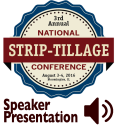Advertise Follow Us
Cover Crops
Uncover the latest information on different species of cover crops and their benefits; tips on the equipment used to seed them; and how strip-tillers are using covers on their farm operation to improve their strip-till systems.
ARTICLES
On this edition of the Strip-Till Farmer podcast, brought to you by Environmental Tillage Systems (ETS), technology editor Noah Newman breaks down everything you can expect at the upcoming 2025 National Strip-Tillage Conference in Iowa City.
Read More
Microbes, Mycorrhizae Key to Understanding Nutrient Content of Cover Crops
Soil health specialist Jim Hoorman unearths relationship between cover crops & nutrient content in the soil
Read More
Strip-Till & Cover Crop Benefits Showcased During CTIC Tour
Garretson, S.D., farmer details journey from conventional tillage to strip-till & no-till
Read More
From Dryland to Dripline: Early Tech Adoption Pays Off for 2025 Strip-Till Innovator
Ray Flickner boosts profitability & water use efficiency with strip-till & subsurface drip irrigation
Read More
Strip-Till Revives Soil After Years of Conventional Tillage
Third-generation farmer solves erosion problems with strip-till & cover crops
Read More
Gauging the Sustainability of Corn-on-Corn
Many Michigan farmers rely on corn-on-corn systems to meet feed demands, but is this short rotation approach truly effective? Here are some considerations for corn-on-corn production systems before sticking with it.
Read More













.png?1692902920)







